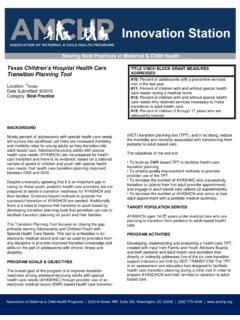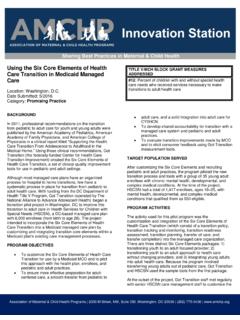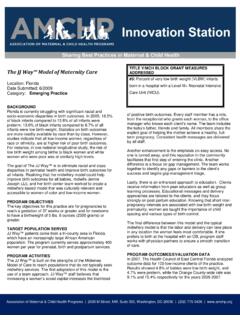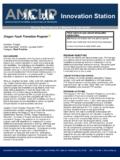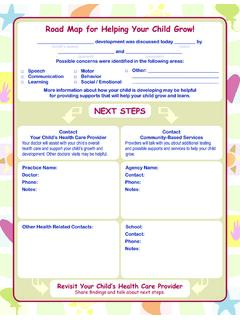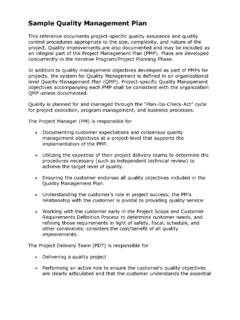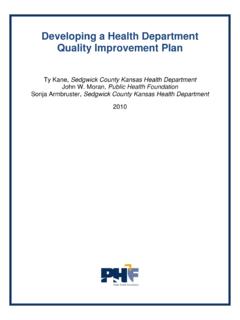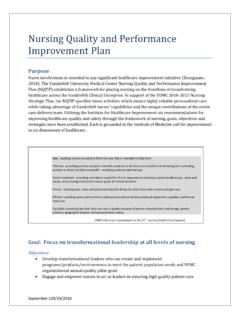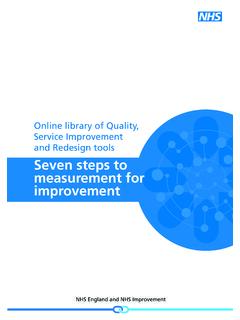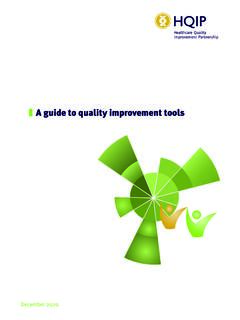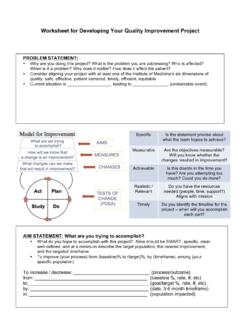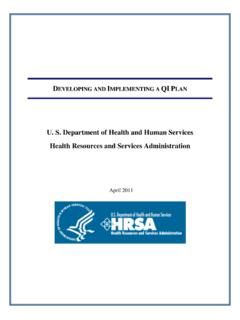Transcription of This document was adapted from information from Center for ...
1 1. This document was adapted from information from Center for Public Health quality , Charlotte Area Health Education Center , NC State University Industrial Extension Service and the Institute for Healthcare improvement . STEP BY STEP GUIDE TO IMPLEMENT quality improvement . SELECT A QI PROJECT. Choosing the right project is important. If the project is the first for your organization it is important to choose one that will be successful and produce results that gain buy-in from others in the organization. (It does not have to be a large project; sometimes smaller projects that produce results have a great impact.) Given the current budget constraints, one recommendation is to choose a project that focuses on improving efficiency within your organization. When choosing a project, consider the following: Where are the gaps between what you desire and your actual performance? (Conduct a Gemba Walk to gather ideas, review your community health assessment, accreditation results, financial performance, and client/staff satisfaction surveys for ideas.)
2 Does the project have a strategic connection for your organization? What areas do front line staff and clients think needs improving? Can the project be done on a small scale and show results within 3 months? How confident are you that the project can be completed successfully? (Consider the leadership support from top to bottom for the project as well as fiscal resources. Implementing projects that will produce early wins will help gain buy-in to do future projects.). Does the project have the Wow! Factor ? Is it an area that desperately needs improvement ? Will showing improvements in this area gain buy-in from staff to do future QI. projects? What is the resistance level from staff/managers/leaders? Choose an initial project that has low resistance. ASSEMBLE A QI TEAM. Selecting the right team is important for successful implementation of your QI project. It is much easier to embrace change when you are involved in helping fix the problem rather than being told how to fix it.
3 Choose your team members based on their knowledge of, and involvement in, the processes that will be affected by your selected improvement project. We recommend a core team of 4-8 individuals, though you may need additional "ad-hoc" team members to contribute at times. Team selection should be linked to your QI project. Try to create a diverse (age, gender, race etc.) and multi-discipline team. As you assemble your team, consider including members who can serve in the following capacities (Note: A. team member sometimes may play more than one role): A Project Sponsor has executive authority and serves as a link to senior management and the strategic aims of the organization, ensures resources and overcomes barriers on behalf of the team, and provides accountability for team members. This individual is not a day-to- day participant in team meetings and testing, but should review the team's progress on a consistent basis.
4 A QI Team Lead is an individual with enough clout to help implement new changes and the authority to allocate the time and resources necessary to achieve the team's aim. It is important that this person have influence over areas that are affected by the change. 2. This document was adapted from information from Center for Public Health quality , Charlotte Area Health Education Center , NC State University Industrial Extension Service and the Institute for Healthcare improvement . Examples of a QI Team Leader may include: Director of Nursing, Middle Manager, or Program Director. The QI Expert may have familiarity with QI methods and understands the processes and procedures that are the focus of improvement efforts. This individual has a good working relationship with colleagues, can get things done, and knows who to consult with when additional support or clinical/technical information is needed to guide the improvement efforts.
5 Examples of QI Experts may include: quality improvement / quality Assurance Coordinator. Local Experts are front-line staff whose daily work occurs in the area that is the focus of the improvement . They have a thorough understanding of the processes and procedures and can identify ideas for how to improve the process. They will benefit directly from changes and are able to understand the effects of proposed changes and have the desire and ability to drive the improvement project on a daily basis. Be sure to include local experts from all disciplines/roles involved in the process ( , local experts for a clinical project may be clinical providers, nurses, technicians, and clerical staff.). Outside Perspective is an individual who is not directly involved in the process and can provide a fresh perspective to the process. They often ask the why is it done that way? . questions and often suggest innovative changes to improve the process.
6 This individual should not be timid to speak up and ask the why? questions ( , for clinical projects an outside perspective may be someone from Environmental Health.). QI Project Manager is usually the QI Team Leader or Local Expert who provides organization and management for the project. Specifically, they are detail oriented and the driver behind the project. They help the team stay on track by developing timelines, monitoring progress on the project tasks, and facilitating team meetings. Example QI Projects and Teams Project Example 1: We aim to increase the number of patients scheduled for Primary Care Clinic, in order to increase services to our citizens, and thereby increase revenue for the Primary Care Clinic to assure sustainability by October 1, 2010. We will achieve this by reviewing our current Primary Care Clinic flow. Team Members: QI Coordinator (QI Team Lead), Secretary, Medical Office Assistant, LPN - Primary Care, Lead Nurse, Director of Nursing, and Environmental Health Specialist Project Example 2: We aim to increase efficiency for accessing septic system permits by 80% in order to increase both internal and external customer satisfaction.
7 Because the current process is time consuming, involves many steps, is occasionally inaccurate, and the filing process is outdated. Goals: Efficiency for accessing septic system permit documents will be increased by 80%. Internal and external customer satisfaction will be increased by 80%. Team Members: Director of Public Health Development (QI Team Lead), On Site Waste Water Program Specialist EH. Supervisor I, Office Assistant IV, and EH Specialist 3. This document was adapted from information from Center for Public Health quality , Charlotte Area Health Education Center , NC State University Industrial Extension Service and the Institute for Healthcare improvement . DEVELOP AN AIM STATEMENT (Answers the question: What are we trying to accomplish?). How many times have you been part of a project that lacks direction? Lack of direction and scope can lead to wasted resources, frustration, and even project failure.
8 An aim statement acts as your compass to guide and focus your team's efforts. It is an explicit statement of the desired outcome of your improvement project. It is Specific, Measureable, Achievable, Relevant, and Time bound. A good aim statement includes the following components: What are we trying to accomplish? o Identify the problem and identify the overall goal ( your long term outcome). o Use words like improve, reduce, and increase Why is it important? o This should answer the questions so what? or why bother doing this project? . Who is the specific target population? o Who or what area is the project focused on? When will this be completed? o Include a specific time for completing the improvements (month/day/year). How will this be carried out? o It is NOT a specific list of tasks/strategies you will do, instead what methods you will use at a high level ( QI methods and principles, Bright Futures toolkit, etc.)
9 What are our measurable goals? o What are some processes and short term outcome goals that will help you know that you have achieved your overall project aim? ( , reduce wait time for child health clinic from 2 hours and 45 minutes to 1 hour and 30 minutes, increase customer satisfaction scores from 50% to 85%, etc.). o Include 4-6 goals o The goals are similar to SMART objectives--remember you want to have stretch' goals. For example, if your baseline data for time to process an application is 15 days you would not want to make your goal 12 days, because your team would not have to stretch to meet that goal.). DEVELOP MEASURES (Answers the question: How will we know our changes are an improvement ?). Have you ever changed something? How did you know that the change you made was an improvement ? You probably had some kind of data to assess the improvement ( , a tally of positive comments from observers or before and after pictures).
10 When doing an improvement project measurement is a key ingredient. It helps show results and achievements toward your desired goal and also helps replace personal subjectivity so that you do not rely on the notion of I think or I feel that things are better . Instead, you have data to actually show if the changes you make are improving your current process. As you collect data for your project, you should include three types of measures, which are linked to your project aim and goals. These measures include: Outcome-the ultimate results you are trying to achieve o Examples: Overall wait time for family planning visit, time to receive final septic tank permit, overall time to process an application, etc. 4. This document was adapted from information from Center for Public Health quality , Charlotte Area Health Education Center , NC State University Industrial Extension Service and the Institute for Healthcare improvement .
